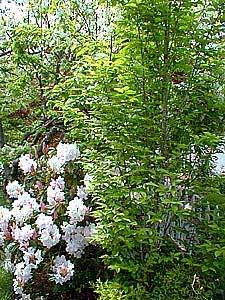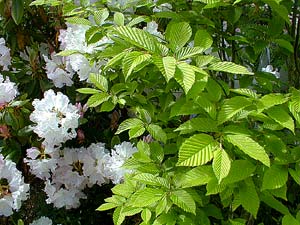 Columnar European Hornbeam
Columnar European Hornbeam
"I think that I shall never see
A billboard lovely as a tree."
-Ogden Nash
(1902-1971)
(1902-1971)
Our columnar hornbeam tree lends shade to the Loder's White Rhododendron to its left & an Apricot Surprise Azalea to its right, with fuchsias right at the base of the trunk.
One of the good things about such a narrow upright tree is it permits some crowding. "Fastigiata" or fastigiate means "pointed upright." It is the most common of the cultivars of Carpinus betulus. This variety has pretty much displaced the natural species tree from the nursery trade. It's a good choice to provide a little shade to rhododendron species because they like the same rich moist acidic soils.
Ours is probably only about 15 to 18 feet tall. At this size it is extremely columnar; it will broaden into more of an egg-shape as it ages. It could someday be 30 or 50 feet tall, conceivably taller, yet is suited to smallish yards because of its narrow form.
 When it does become large, it is so thickly leafed, it may be a bit too much shade for the rhodies planted near it, as the rhodies do like half-sunlight or dappled-sun.
When it does become large, it is so thickly leafed, it may be a bit too much shade for the rhodies planted near it, as the rhodies do like half-sunlight or dappled-sun.But I do think ahead. Not far distant from the hornbeam is an exceedingly elderly chokecherry tree, which provides a great deal of shade to that corner of he yeard. Alas, it is approaching the end of its life, & is suffering some trunk rot at the site of a decades-old wound. With luck we expect to have it for another ten years, but the arborist we consulted could only tell us that trees don't live forever & this one's as old as chokecherries get.
 So by the time the hornbeam is a big tree, the chokecherry will be gone, & the amount of shade in that area will still be about right for the rhodies.
So by the time the hornbeam is a big tree, the chokecherry will be gone, & the amount of shade in that area will still be about right for the rhodies.Although hornbeams are at some risk when first planted, if they make it through their first winter, they become impervious thereafter, putting up with imperfect conditions, & not susceptible to diseases.
Its autumn coloration can be intensely yellow, though for us it has been only moderately good for autumn color. The grey & white mottled bark is attractive, so that the tree has a certain elegance even when it is leafless in winter.
Hornbeams are in the birch family, & are the European equivalent of the North American ironwood tree, having dense close-grained wood traditionally used for carving wooden bowls, tool handles, flooring, ox yokes, & furniture. The Romans used hornbeam to make their chariots.
When I am trying to frame a picture in the camera, it really makes me look intensely at how something looks from every angle. Whether viewed from the sidewalk, or from within the yard, up close, or from across the way, the hornbeam is always lovely. In a small yard like ours, with lots of shrubs & small trees, it can be difficult to stand far enough away from a tree to photograph the whole thing, because head-high shrubbery here & there gets in the way of the shot. But I've done what I could to give an impression of our young hornbeam, hoping you can see it as I see it. It is a "regular" common tree, but regular trees are often beauties.
I took the photos on this page on May Day, while the hornbeam's immediate neighbor, the Loder's White, was in full bloom.